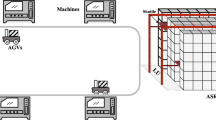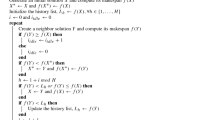Abstract
Scheduling is a key factor for manufacturing productivity. Effective scheduling can improve on-time delivery of products, reduce inventory, cut lead times, and improve the utilization of bottleneck resources. This study was motivated by the design and implementation of a scheduling system for the manufacturing of Toshiba's gas insulated switchgears. The manufacturing is characterized by significant machine setup times, strict local buffer capacities, the option of choosing a few alternative processing routes, and long horizon as compared to the time resolution required. This problem has been recognized to be extremely difficult because of the combinatorial nature of integer optimization and the large size of the real problem. Our goal is thus to obtain near-optimal schedules with quantifiable quality in a computationally efficient manner. To achieve this goal, a novel integer optimization formulation with a separable structure is developed, and a solution methodology based on a combined Lagrangian relaxation, dynamic programming, and heuristics is developed. The method has been implemented using the object-oriented programming language C++, and numerical testing shows that the method generates high-quality schedules in a timely fashion to achieve on-time delivery of products and low inventory. Through explicit consideration of setups, tanks with the same processing requirements tend to be processed together to avoid excessive setups. The integrated treatment of machines and buffers facilitates the smooth flow of parts through the system. The embedded routing selection mechanism also balances the load among candidate routes. Finally, the newly developed "time step reduction technique" implicitly establishes two time scales to reduce computational requirements without much loss of modeling accuracy and scheduling performance, thereby enabling the resolution of long horizon problems with controllable computational requirements.
Similar content being viewed by others
References
P.B. Luh and D.J. Hoitomt, Scheduling of manufacturing systems using the Lagrangian relaxation technique, IEEE Transactions on Automatic Control 38(1993)1066.
H. Chen, C. Chu, and J.M. Proth, A more effective Lagrangian relaxation aproach, Proc. IEEE Int. Conf. on Robotics and Automation, Nagoya, Japan, 1995, p. 496.
L.J. Krajewski, B.E. King, L.P. Ritzman and D.S. Wong, Kapan, MRP and shaping the manufacturing environment, Management Science 33(1987)39.
S.S. Panwalkar, R.A. Dudek and M.L. Smith, Sequencing research and the industrial scheduling problem, Symposium on the Theory of Scheduling and Its Applications, 1973, p. 29.
K.R. Baker, Introduction to Sequencing and Scheduling, Wiley, New York, 1974.
W.C. Driscoll and H. Emmons, Scheduling production on one machine with changeover costs, AIIE Trans. 9(1977)338.
C.H. White and R.C. Wilson, Sequence dependent set-up times and job sequencing, Int. J. Prod. Res. 15(1977)191.
I. Adiri and N. Amit, Route-dependent open shop scheduling, IIE Trans. 15(1983)231.
S.K. Gupta, Njobs and Mmachines job-shop problems with sequence dependent setup times, Int. J. Prod. Res. 20(1982)643.
B.L. Golden and W.R. Stewart, Empirical analysis of heuristics, in: The Traveling Salesman Problem, E.L. Lawler, J.K. Lenstra, A.H.G. Rinooy Kan and D.B. Shmoys, eds., Wiley, Chichester, 1985, p. 361.
E. Uskup and S.B. Smith, A branch and bound algorithm for two-stage production sequencing problems, Operations Research 23(1975)118.
I.M. Ovacik and R. Uzsoy, Rolling horizon procedures for dynamic parallel machine scheduling with sequence-dependent setup times, Int. J. Prod. Res. 33(1995)3173.
C. Zhou and P.J. Egbelu, Scheduling in a manufacturing shop with sequence-dependent setups, Robotics and Computer-Integrated Manufacturing 5(1989)73.
S.C. Kim and P.M. Bobrowski, Impact of sequence-dependent setup time on job shop scheduling performance, Int. J. Prod. Res. 32(1994)1503.
P.A. Rubin and G.L. Ragatz, Scheduling in a sequence dependent setup environment with generic search, Computers and Operations Research 22(1995)85.
K. Mori, M. Tsukiyama, and T. Fukuda, A hybrid scheduling method for the job shop scheduling problem, Transactions of the Institute of Electrical Engineers of Japan, Part C, 9(1992)568.
T.A. Owens and P.B. Luh, Improving the time resolution of schedules generated via Lagrangian relaxation algorithms, Proc. 1992 IEEE Int. Conf. on Systems, Man and Cybernetics, Chicago, IL, 1992, p. 1390.
J. Wang and P.B. Luh, Scheduling of a machining center, Mathematical and Computer Modeling 24(1996)203.
R.N. Tomastik and P.B. Luh, The facet ascending algorithm for integer programming problems, Proc. 32nd IEEE Conf. on Decision and Control, San Antonio, TX, 1993, p. 2880.
C. Lemarechal, Bundle methods in nonsmooth optimization, in: Nonsmooth Optimization, Proc. of an IIASA Workshop, C. Lemarechal and R. Mifflin, eds., Pergamon Press, 1978.
J.B. Hiriart-Urruty and C. Lemarechal, Convex Analysis and Minimization Algorithms, I and II, Springer, Berlin, 1993.
R.N. Tomastik and P.B. Luh, A reduced-complexity bundle method for maximizing concave nonsmooth functions, Proc. 35th IEEE Conf. on Decision and Control, Kobe, Japan, Dec. 1996.
L. Gou, Holonic manufacturing scheduling: Architecture, cooperation mechanism, and implementation, Ph.D. Dissertation, University of Connecticut, 1997.
J. Wang and P.B. Luh, A combined Lagrangian relaxation and dynamic programming algorithm for job shop scheduling, Proc. 5th Rensselaer Int. Conf. on Computer Integrated Manufacturing and Automation Technology, Grenoble, France, May 1996, p. 3.
Rights and permissions
About this article
Cite this article
Luh, P.B., Gou, L., Zhang, Y. et al. Job shop scheduling with group-dependent setups, finite buffers, and long time horizon. Annals of Operations Research 76, 233–259 (1998). https://doi.org/10.1023/A:1018948621875
Issue Date:
DOI: https://doi.org/10.1023/A:1018948621875




